Related Research Articles
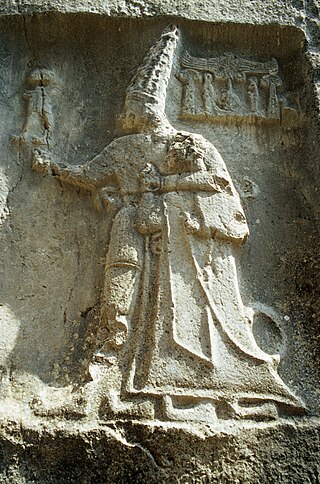
Šarruma, also romanized as Šarrumma or Sharruma, was a Hurrian god. He could be depicted in both anthropomorphic form, sometimes riding on the back of a leopard, and in the theriomorphic form as a bull. His character is not fully understood, though it is known that he could function as a mountain god. He was regarded as a son of Ḫepat and Teshub. He was also linked to various moon deities. Additionally, the only mythological text he appears in addresses him as a messenger (sukkalu) of Kumarbi. He was worshiped by Hurrians in southeastern Anatolia and northern Syria, for example in Kummanni and Lawazantiya in Kizzuwatna. From this kingdom he was introduced to the Hittite pantheon as well. Hittite influence in turn resulted in his introduction to cities such as Aleppo, Emar and Ugarit. He was also venerated in Luwian religion in the first millennium BCE, with theophoric names invoking him attested from as late as the Hellenistic period in Cilicia and Lycia.
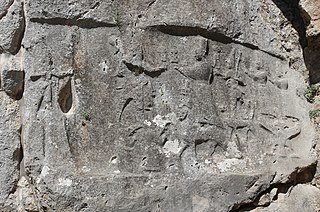
Ḫepat was a goddess associated with Aleppo, originally worshiped in the north of modern Syria in the third millennium BCE. Her name is often presumed to be either a feminine nisba referring to her connection to this city, or alternatively a derivative of the root ḫbb, "to love". Her best attested role is that of the spouse of various weather gods. She was already associated with Adad in Ebla and Aleppo in the third millennium BCE, and in later times they are attested as a couple in cities such as Alalakh and Emar. In Hurrian religion she instead came to be linked with Teshub, which in the first millennium BCE led to the development of a tradition in which she was the spouse of his Luwian counterpart Tarḫunz. Associations between her and numerous other deities are described in Hurrian ritual texts, where she heads her own kaluti, a type of offering lists dedicated to the circle of a specific deity. She commonly appears in them alongside her children, Šarruma, Allanzu and Kunzišalli. Her divine attendant was the goddess Takitu. In Hittite sources, she could sometimes be recognized as the counterpart of the Sun goddess of Arinna, though their respective roles were distinct and most likely this theological conception only had limited recognition. In Ugarit the local goddess Pidray could be considered analogous to her instead.
Kamrušepa was a Hittite and Luwian goddess of medicine and magic, analogous to Hattic and Palaic goddess Kataḫzipuri. She is best known as one of the deities involved in the Telepinu Myth, in which her actions were crucial to pacify the anger of the "missing" vegetation god.
Pirwa, also known under the variant names Perwa and Peruwa, was a god worshiped by Hittites and Luwians in ancient Anatolia. He was associated with horses. There is also evidence that he was regarded as a warlike deity. He is first attested in documents from Kanesh, which mention a priest in his service. He retained his connection with this city in later sources, but he also came to be worshiped in a number of other locations, including Hattusa. A possible late reference to him occurs in a Neo-Assyrian text listing deities worshiped in Arbela, though this attestation remains uncertain and might be a scribal mistake.

Ishara (Išḫara) was a goddess originally worshipped in Ebla and other nearby settlements in the north of modern Syria in the third millennium BCE. The origin of her name is disputed, and due to lack of evidence supporting Hurrian or Semitic etymologies it is sometimes assumed it might have originated in a linguistic substrate. In Ebla, she was considered the tutelary goddess of the royal family. An association between her and the city is preserved in a number of later sources from other sites as well. She was also associated with love, and in that role is attested further east in Mesopotamia as well. Multiple sources consider her the goddess of the institution of marriage, though she could be connected to erotic love as well, as evidenced by incantations. She was also linked to oaths and divination. She was associated with reptiles, especially mythical bašmu and ḫulmiẓẓu, and later on with scorpions as well, though it is not certain how this connection initially developed. In Mesopotamian art from the Kassite and Middle Babylonian periods she was only ever represented through her scorpion symbol rather than in anthropomorphic form. She was usually considered to be an unmarried and childless goddess, and she was associated with various deities in different time periods and locations. In Ebla, the middle Euphrates area and Mesopotamia she was closely connected with Ishtar due to their similar character, though they were not necessarily regarded as identical. In the Ur III period, Mesopotamians associated her with Dagan due to both of them being imported to Ur from the west. She was also linked to Ninkarrak. In Hurrian tradition she developed an association with Allani.
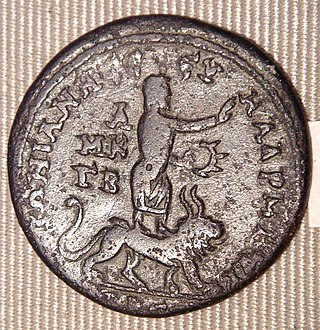
Šanta (Santa) was a god worshiped in Bronze Age Anatolia by Luwians and Hittites. It is presumed that he was regarded as a warlike deity, and that he could additionally be associated with plagues and possibly with the underworld, though the latter proposal is not universally accepted. In known texts he frequently appears alongside Iyarri, a deity of similar character. He is first attested in documents from Kanesh dated to the Old Assyrian period, and continues to appear in later treaties, ritual texts and theophoric names. He is also present in an offering lists from Emar written in Akkadian, though he did not belong to the local pantheon and rituals involving him were only performed on behalf of the Hittite administration by local inhabitants.
Maliya was a goddess worshiped by Hittites in the Bronze Age. She was most likely a deified river in origin, but she was also associated with gardens and with artisanship, specifically with leatherworking and carpentry. The oldest attestations of her have been identified in the Old Assyrian texts from Kanesh. This city continued to be associated with her in later tradition, though she was also worshiped in Hattusa and elsewhere in the Hittite Empire. She is also present in texts originating in Kizzuwatna, which indicate she had a temple in Kummanni, where she was worshiped alongside various Hurrian deities.

Šimige was the Hurrian sun god. Known sources do not associate him with any specific location, but he is attested in documents from various settlements inhabited by the Hurrians, from Kizzuwatnean cities in modern Turkey, through Ugarit, Alalakh and Mari in Syria, to Nuzi, in antiquity a part of the kingdom of Arrapha in northeastern Iraq. His character was to a large degree based on his Mesopotamian counterpart Shamash, though they were not identical. Šimige was in turn an influence on the Hittite Sun god of Heaven and Luwian Tiwaz.
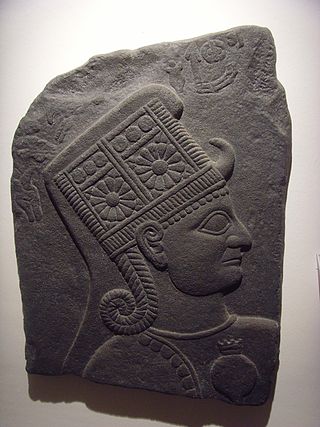
Kubaba was a goddess of uncertain origin worshiped in ancient Syria. Despite the similarity of her name to these of legendary queen Kubaba of Kish and Phrygian Cybele, she is considered a distinct figure from them both. Her character is poorly known. Multiple local traditions associating her with other deities existed, and they cannot necessarily be harmonized with each other. She is first documented in texts from Kanesh and Alalakh, thoug her main cult center was Carchemish. She was among the deities worshiped in northern Syria who were incorporated into Hurrian religion, and in Hurrian context she occurs in some of the Ugaritic texts. She was also incorporated into Hittite religion through Hurrian intermediaties. In the first millennium BCE she was worshiped by Luwians, Arameans and Lydians, and references to her can be found in a number of Greek texts.
Adamma was a goddess worshiped in Ebla in the third millennium BCE, later also documented in Hurrian sources and in Emar. The origin and meaning of her name remain a matter of debate among researchers. It is commonly assumed that it originated in one of the Semitic languages and that it can be compared to Hebrew ʾădāmâ, "soil" or "earth". An alternate view is that it belongs to a linguistic substrate at some point spoken in part of modern Syria. Hurrian origin has been proposed as well, but is considered implausible. In Ebla, Adamma received sacrificial sheep on behalf of the royal palace. She also had clergy of her own, as evidenced by references to a dam-dingir priestess in her service. Eblaite texts indicate she was also venerated in Hadani and Tunip. She was locally regarded as the spouse of Resheph, though the connection between them is not attested in later sources. After the fall of Ebla, she was incorporated into Hurrian religion, and in this context appears in Hittite and Ugaritic sources as well, often forming a pair with Kubaba. Furthermore, she was worshiped in Emar, where under the name Adammatera she might have been perceived as a deity associated with storage areas and the underworld. It is also possible that the goddess Admu known from Mari and from the Mesopotamian god list An = Anum was the same deity.
Shuwala (Šuwala) was a Hurrian goddess who was regarded as the tutelary deity of Mardaman, a Hurrian city in the north of modern Iraq. She was also worshiped in other Hurrian centers, such as Nuzi and Alalakh, as well as in Ur in Mesopotamia, Hattusa in the Hittite Empire and in the Syrian cities Emar and Ugarit.
Ugur was a Mesopotamian god associated with war and death, originally regarded as an attendant deity (sukkal) of Nergal. After the Old Babylonian period he was replaced in this role by Ishum, and in the Middle Babylonian period his name started to function as a logogram representing Nergal. Temples dedicated to him existed in Isin and Girsu. He was also worshiped outside Mesopotamia by Hurrians and Hittites. He might also be attested in sources from Emar.

Nabarbi or Nawarni was a Hurrian goddess possibly associated with pastures. She was one of the major deities in Hurrian religion, and was chiefly worshiped in the proximity of the river Khabur, especially in Taite. It has been proposed that she was associated with the goddess Belet Nagar, linked to the Upper Mesopotamian city of Nagar. In addition to being venerated in Hurrian religion, she was also incorporated into the beliefs of the Hittites and into the local pantheon of Emar. She also continued to be worshiped in Taite in the Neo-Assyrian period, as attested in a text from the reign of Ashurbanipal, where she is one of the deities invoked to bless the king.
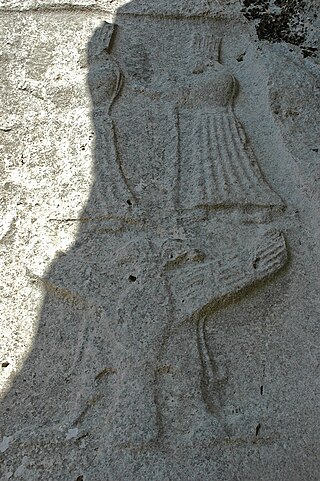
Allanzu, later known under the name Alasuwa, was a Hurrian goddess regarded as a daughter of Ḫepat. She was described as a youthful deity and in known texts often appears in association with her mother and siblings. She was also worshiped by Hittites and Luwians.
Taru was a weather god worshiped in ancient Anatolia by Hattians. He was associated with the bull, and could be depicted in the form of this animal. It is presumed that the names of the Hittite and Luwian weather gods, Tarḫunna and Tarḫunz, while etymologically Indo-European, were meant to resemble Taru's as a result of Hattian cultural influence on other cultures of the region.
Ḫalki was the Hittite deity of grain. While it is commonly assumed the name consistently referred to a goddess, a male form of this deity has also been identified. Ḫalki was associated with other grain deities, namely Mesopotamian Nisaba and Hattian Kait, with the latter presumed to be functionally identical. The oldest attestations come from Kanesh, though they are limited to theophoric names. In later periods, the female form of Ḫalki was worshiped in Hattusa, and the male one in Nerik, though evidence from other cities is also available.
Iyaya was a Hittite and Luwian goddess. Her functions remain uncertain, though it has been suggested she was associated with water or more broadly with nature. She might have been associated with the god Šanta, though the available evidence is limited. Her main cult centers were Lapana and Tiura, though she was also worshiped in other cities.
Aškašepa was a Hittite deity presumed to be a deified mountain, possibly Mount Erciyes. He is first attested in a treaty from Kanesh, and continued to be regarded as one of the deities associated with this city in later sources. He was worshiped in cities such as Hattusa, Ištanuwa and Karaḫna. He also appears in a number of international treaties between the rulers of the Hittite Empire and other contemporary monarchs as one of the invoked divine witnesses.
Nipas was a god worshiped in Kanesh. His name might have been derived from the Hittite word nepis, "heaven", and he might have been a weather god. While he was most likely one of the main deities of the city, and a temple, festival and clergy associated with him are attested, for unknown reasons he does not appear in any later sources.
Tenu was a Hurrian god regarded as a divine attendant (sukkal) of Teshub. He might have originated in a local tradition typical for Aleppo. He appears in a number of Hurrian offering lists (kaluti), as well as Hittite and Emariote texts.
References
- 1 2 3 4 Kryszat 2006, p. 108.
- 1 2 3 4 5 6 7 Taracha 2009, p. 28.
- 1 2 Veenhof 2018, p. 52.
- 1 2 Veenhof & Eidem 2008, p. 236.
- ↑ Taracha 2009, pp. 27–28.
- 1 2 Haas 2015, p. 568.
- 1 2 Barjamovic 2022, p. 536.
- ↑ Kryszat 2006, pp. 109–110.
- ↑ Haas 2015, p. 676.
- 1 2 Kryszat 2006, p. 106.
- ↑ Kryszat 2006, p. 104.
- ↑ Kryszat 2006, p. 118.
- ↑ Veenhof 2018, p. 82.
- ↑ Veenhof & Eidem 2008, p. 229.
- 1 2 Kryszat 2006, p. 119.
- ↑ Taracha 2009, p. 29.
- ↑ Taracha 2009, p. 27.
- ↑ Kryszat 2006, p. 121.
- ↑ Taracha 2009, pp. 29–30.
- ↑ Taracha 2009, p. 30.
- ↑ Taracha 2009, p. 42.
- ↑ Taracha 2009, p. 45.
- 1 2 Taracha 2009, p. 48.
- ↑ Taracha 2009, p. 117.
- 1 2 3 Fleming 2000, p. 162.
- ↑ Veenhof & Eidem 2008, p. 235.
- ↑ Fleming 2000, pp. 162–163.
- ↑ Beckman 2002, p. 40.
- ↑ Beckman 2002, p. 50.
- ↑ Fleming 2000, p. 146.
- ↑ Fleming 2000, p. 145.
- ↑ Fleming 2000, p. 163.
Bibliography
- Barjamovic, Gojko (2022). "Before the Kingdom of the Hittites". The Oxford History of the Ancient Near East: Volume II. Oxford University Press. pp. 497–565. doi:10.1093/oso/9780190687571.003.0017. ISBN 978-0190687571.
- Beckman, Gary (2002). "The Pantheon of Emar". Silva Anatolica: Anatolian studies presented to Maciej Popko on the occasion of his 65th birthday. Warsaw: Agade. hdl:2027.42/77414. ISBN 83-87111-12-0. OCLC 51004996.
- Fleming, Daniel E. (2000). Time at Emar: The Cultic Calendar and the Rituals from the Diviner's Archive. Pennsylvania State University Press. ISBN 978-1-57506-044-6 . Retrieved 2022-11-26.
- Haas, Volkert (2015) [1994]. Geschichte der hethitischen Religion. Handbook of Oriental Studies. Section 1: The Near and Middle East (in German). Brill. ISBN 978-90-04-29394-6 . Retrieved 2022-11-26.
- Kryszat, Guido (2006). "Herrscher, Herrschaft und Kulttradition in Anatolien nach den Quellen aus den altassyrischen Handelskolonien - Teil 2: Götter, Priester und Feste Altanatoliens". Altorientalische Forschungen (in German). Walter de Gruyter GmbH. 33 (1). doi:10.1524/aofo.2006.33.1.102. ISSN 2196-6761. S2CID 164077437.
- Taracha, Piotr (2009). Religions of Second Millennium Anatolia. Dresdner Beiträge zur Hethitologie. Vol. 27. Wiesbaden: Harrassowitz Verlag. ISBN 978-3447058858.
- Veenhof, Klaas R. (2018). "The Family God in Old Babylonian and Especially in Old Assyrian Sources". Revue d'assyriologie et d'archéologie orientale (112): 49–90. doi: 10.3917/assy.112.0049 . ISSN 0373-6032 . Retrieved 2022-11-26.
- Veenhof, Klaus R.; Eidem, Jesper (2008). Mesopotamia: the Old Assyrian period. Fribourg: Academic Press. ISBN 978-3-525-53452-6. OCLC 244654503.